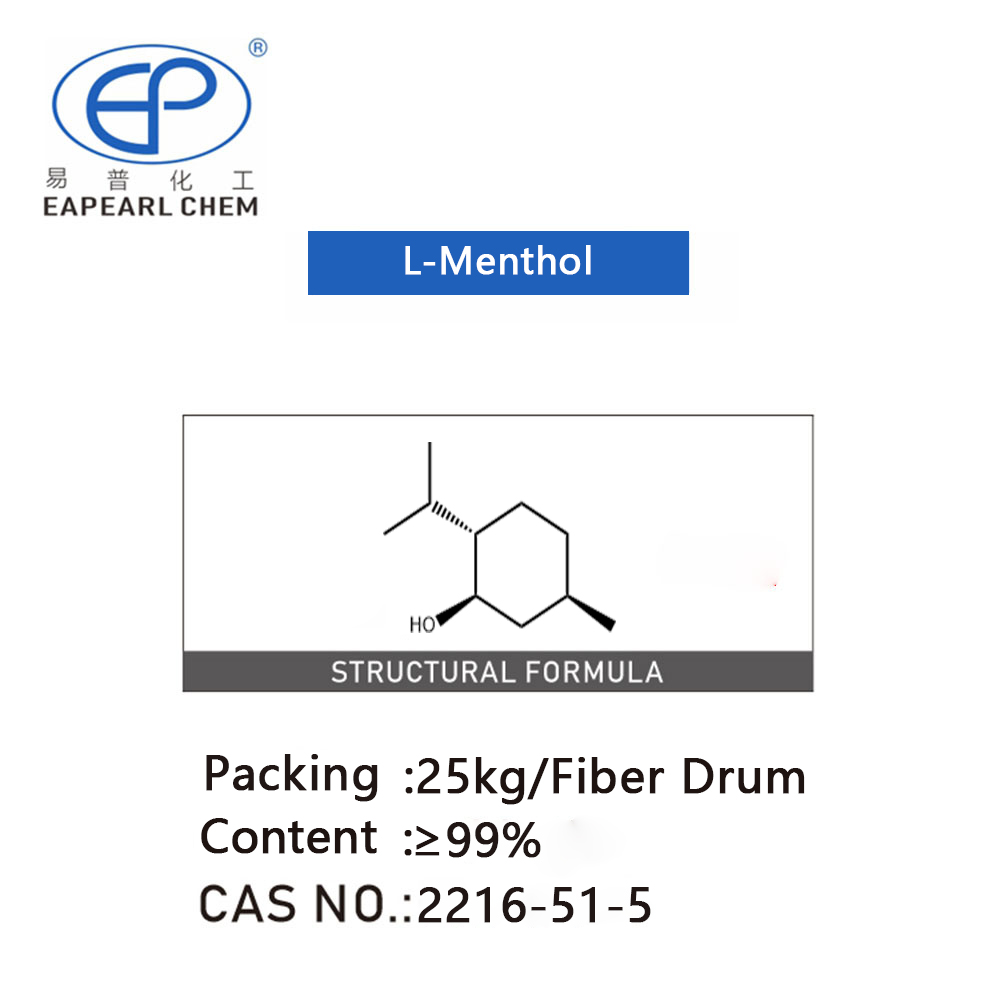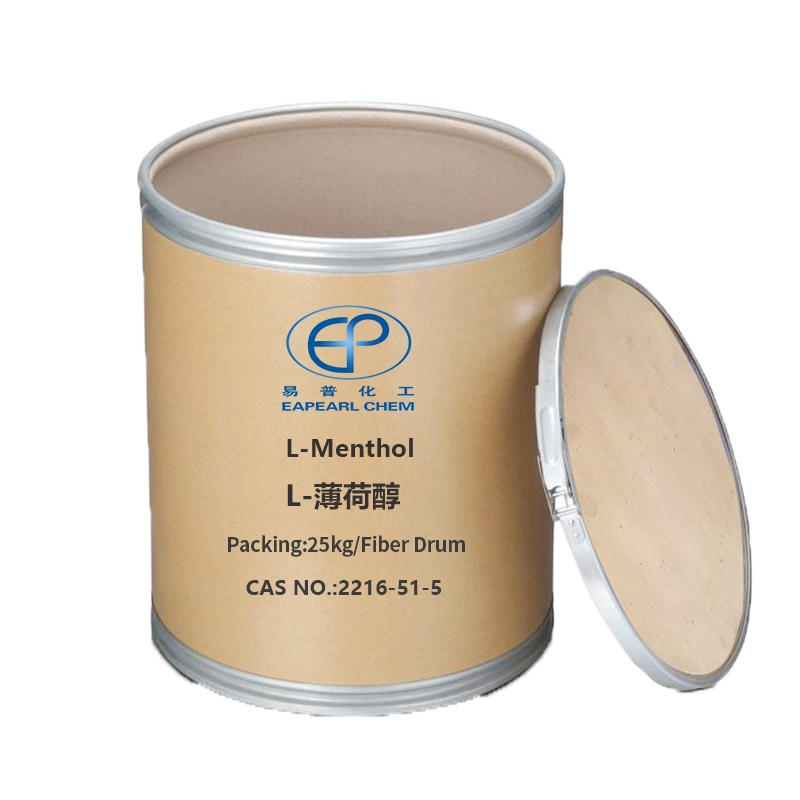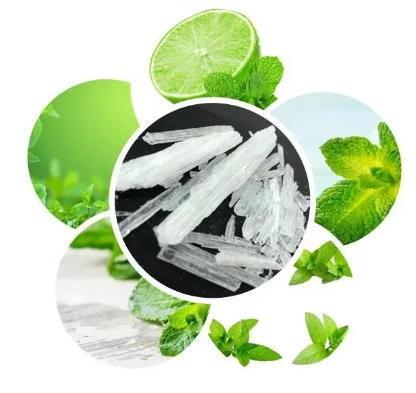L-Menthol
Experience the Purest, Most Effective L-Menthol for Your Needs
High-quality L-Menthol for Pharmaceuticals, Food, and Cosmetics
Discover the incredible properties of L-Menthol, a natural organic compound celebrated for its minty flavor and cooling sensation. Extracted from the finest mint oils, our L-Menthol is perfect for a wide range of applications, ensuring top-notch quality and performance every time.
Why Choose Our L-Menthol?
Purity and Quality: Our L-Menthol guarantees high purity and consistency, making it ideal for pharmaceuticals, food, and cosmetics. Each batch undergoes rigorous testing to meet the highest standards.
Certification: Our L-Menthol complies with FDA, EU, and GMP standards, ensuring that you receive a product that meets all regulatory requirements.
Packaging Integrity: We offer robust and convenient packaging that protects your L-Menthol from moisture, light, and air, maintaining its quality and effectiveness.


Alias: levomenthol; L(-)-Menthol; (R)-(-)-Menthol; (1R,2S,5R)-2-Isopropyl-5-methylcyclohexanol;
Chemical Formula: C10H20O
Molecular Weight: 156.27 g/mol
Appearance: L-Menthol typically appears as colorless or white crystalline solid with a strong minty odor.
Melting Point: 42-44°C (107.6-111.2°F)
Boiling Point: 212°C (413.6°F)
Solubility: L-Menthol is slightly soluble in water but highly soluble in alcohols, oils, and chloroform.
L-Menthol, a naturally occurring organic compound, is widely recognized for its characteristic minty aroma and cooling properties. Extracted primarily from peppermint oil, L-Menthol is an essential ingredient in various industries, including pharmaceuticals, food, cosmetics, and personal care products. Its unique sensory effects make it highly valued for both its aromatic and therapeutic benefits.
L-Menthol Packaging Information


L-Menthol
CAS: 2216-51-5
Purity: ≥99%
Packing: 25kg/Fiber Drum


Applications of L-Menthol
L-Menthol is used in a variety of applications due to its cooling and aromatic properties. Here are some of the key uses:
Pharmaceuticals:
- Topical Analgesics: L-Menthol is widely used in topical pain relief products such as ointments, creams, and gels. Its cooling sensation helps alleviate minor aches and pains.
- Cough and Cold Products: Included in throat lozenges, nasal inhalers, and cough syrups, L-Menthol provides a soothing effect and helps relieve congestion.
- Oral Care: Used in toothpaste and mouthwashes, L-Menthol offers a fresh, minty flavor and a cooling sensation that enhances oral hygiene.
Food and Beverages:
- Flavoring Agent: L-Menthol is a popular flavoring agent in confectioneries, chewing gums, and beverages. Its refreshing mint flavor is highly appealing to consumers.
- Aromatics: It is also used in flavoring oils and extracts to provide a cooling effect and enhance the overall sensory experience of food products.


Cosmetics and Personal Care:
- Skin Care Products: L-Menthol is incorporated into lotions, creams, and aftershaves for its cooling and soothing properties, which help calm irritated skin.
- Hair Care: Found in shampoos and conditioners, it provides a refreshing sensation on the scalp.
- Deodorants: L-Menthol’s cooling effect is used in deodorants and antiperspirants to provide a long-lasting fresh feeling.
L-Menthol’s versatility and beneficial properties make it an indispensable ingredient in many industries. Its applications range from providing pain relief and soothing effects in pharmaceuticals, to enhancing flavor and aroma in food and beverages, to offering refreshing and cooling sensations in cosmetics and personal care products, and even to promoting relaxation and stress relief in aromatherapy.
REQUEST A QUOTE FOR MORE DETAILS
Production Process of L-Menthol
The production of L-Menthol involves several steps, typically starting with the extraction of essential oils from mint plants and concluding with the crystallization of pure L-Menthol. Here’s a detailed description of the process:
1. Extraction of Essential Oils
Raw Material Selection:
- The primary source of menthol is peppermint oil, which is extracted from peppermint (Mentha piperita) plants. Other sources include cornmint (Mentha arvensis).
Harvesting:
- Mint plants are harvested when the oil content is at its peak. The leaves are the primary part of the plant used for oil extraction.
Steam Distillation:
- The harvested mint leaves are subjected to steam distillation. Steam is passed through the plant material, causing the essential oils to vaporize. These vapors are then condensed back into liquid form, resulting in a mixture of water and essential oils.
- The essential oils are separated from the water through decantation or other separation techniques. The resulting peppermint oil contains a high percentage of menthol.
2. Isolation of Menthol
Fractional Distillation:
- The peppermint oil undergoes fractional distillation to separate menthol from other components of the oil. This process exploits the different boiling points of the compounds.
- During distillation, menthol is separated out as a fraction based on its boiling point, typically between 212-216°C.
Cooling and Crystallization:
- The menthol-rich fraction is then cooled to initiate crystallization. L-Menthol, which has a higher melting point than other isomers, crystallizes out of the mixture.
- The crystallized L-Menthol is collected and further purified.
3. Purification of L-Menthol
Recrystallization:
- The crude menthol crystals are dissolved in an appropriate solvent (like ethanol) and then cooled again to form purer L-Menthol crystals. This process may be repeated multiple times to achieve the desired purity level.
Centrifugation and Filtration:
- The solution is subjected to centrifugation or filtration to separate the pure L-Menthol crystals from the solvent. The crystals are then dried to remove any remaining solvent residues.
4. Quality Control and Packaging
Quality Testing:
- The purified L-Menthol is subjected to rigorous quality control tests to ensure it meets industry standards. This includes checking the melting point, specific rotation, purity (typically above 99%), and the absence of contaminants.
- High-performance liquid chromatography (HPLC) and gas chromatography (GC) are commonly used analytical techniques for this purpose.
Technical Data of L-Menthol
| Name | L-Menthol |
| Synonyms | levomenthol; L(-)-Menthol; (R)-(-)-Menthol; (1R,2S,5R)-2-Isopropyl-5-methylcyclohexanol; |
| CAS | 2216-51-5 |
| EINECS | 218-690-9 |
| Molecular Formula | C10H20O |
| Molar Mass | 156.27 |
| Density | 0.89 g/mL at 25 °C (lit.) |
| Melting Point | 41-45 °C (lit.) |
| Boling Point | 212 °C (lit.) |
| Specific Rotation(α) | -51 º (589nm, c=10, EtOH) |
| Flash Point | 200°F |
| Water Solubility | insoluble |
| Solubility | Soluble in organic solvents such as ethanol, acetone, ether, chloroform and benzene, slightly soluble in water. |
| Vapor Presure | 0.8 mm Hg ( 20 °C) |
| Appearance | Colorless needle crystal |
| Specific Gravity | 0.89 |
| Color | Colorless to white |
| Merck | 145,837 |
| BRN | 1902293 |
| pKa | 15.30±0.60(Predicted) |
| Storage Condition | Store below +30°C. |
| Stability | Stable. |
| Refractive Index | 1.46 |
| MDL | MFCD00062979 |
| Physical and Chemical Properties | Colorless needle-like crystals with a cool aroma of mint. Relative density d1515 = 0.890, melting point 41~43 ℃, boiling point 216 ℃,111 ℃(2.67kPa), specific optical rotation αD20 =-49.3 °, refractive index nD20 = 1.4609. Soluble in ethanol, acetone, ether, chloroform and benzene and other organic solvents, water-soluble. The chemical properties are relatively stable, and can be volatilized with steam. Rat oral LD503.3g/kg,ADI0 ~ 0.2 mg/kg(FAO/WHO,1994). |
| HS Code | 29061100 |
| Toxicity | LD50 orally in Rabbit: 3300 mg/kg LD50 dermal Rabbit > 5000 mg/kg |
| LogP | 3.15 at 25℃ |
REQUEST A QUOTE FOR MORE DETAILS
L-Menthol Storage and Environmental Disposal
L-Menthol, a crystalline substance derived from mint oils, requires proper storage to maintain its quality and efficacy. The storage conditions are crucial to prevent degradation, contamination, and loss of potency.
Storage Conditions:
- Temperature: L-Menthol should be stored in a cool environment, typically between 15-25°C (59-77°F). Excessive heat can cause the crystals to melt and degrade.
- Humidity: It is essential to store L-Menthol in a dry place, with low humidity. Moisture can cause the crystals to clump together and may lead to degradation.
- Light: L-Menthol should be kept in a dark place, away from direct sunlight. Ultraviolet (UV) light can cause the compound to degrade, reducing its effectiveness.
- Air: L-Menthol should be stored in airtight containers to prevent exposure to air, which can lead to oxidation and loss of potency.
Packaging:
- Materials: L-Menthol is typically stored in containers made of materials that do not react with it, such as glass, high-density polyethylene (HDPE), or stainless steel. These materials provide an effective barrier against moisture and light.
- Sealing: Containers should be tightly sealed to prevent contamination and moisture ingress. Desiccants may be included within the packaging to absorb any residual moisture.
Environmental Impact:
- Biodegradability: L-Menthol is biodegradable and breaks down naturally in the environment. However, large quantities should still be managed properly to prevent localized pollution.
- Water Contamination: Care should be taken to prevent L-Menthol from entering water bodies, as it can be harmful to aquatic life. Proper disposal methods should be followed to avoid contamination of rivers, lakes, and oceans.
Regulatory Compliance:
- Local Regulations: Disposal methods should adhere to local environmental regulations and guidelines. This ensures that disposal practices do not harm the environment or public health.
- Safety Data Sheets (SDS): The SDS for L-Menthol provides specific disposal instructions and safety precautions. It is essential to follow these guidelines to ensure safe and compliant disposal.
Advantages of the Chinese L-Menthol Market
Menthol Market: Overview
According to Market Reports World’s latest analysis, the global L-Menthol market size was valued at USD 777 million in 2023 and is forecast to a readjusted size of USD 1091.6 million by 2030 with a CAGR of 5.0% during review period. the report analyzes the L-Menthol markets in key regions. North America and Europe are experiencing steady growth, driven by government initiatives and increasing consumer awareness. Asia-Pacific, particularly China, leads the global L-Menthol market, with robust domestic demand, supportive policies, and a strong manufacturing base.
China’s L-menthol market advantages
1. Robust Domestic Demand
- Consumer Base: China has a large and growing population with increasing consumer demand for products containing L-Menthol. This includes personal care products, pharmaceuticals, and food items, all of which utilize L-Menthol for its cooling properties and fragrance.
- Health and Wellness Trends: Rising awareness and demand for health and wellness products drive the consumption of L-Menthol in various applications, from medicinal products to everyday consumer goods.
2. Supportive Policies
- Government Initiatives: The Chinese government supports the chemical and manufacturing industries through favorable policies, including subsidies, tax incentives, and simplified regulatory procedures. These initiatives lower production costs and encourage innovation.
- Industry Standards: Implementation of stringent industry standards ensures high-quality production, enhancing the competitiveness of Chinese L-Menthol on the global market.
3. Strong Manufacturing Base
- Infrastructure: China boasts advanced manufacturing infrastructure, which facilitates large-scale production and efficient supply chains. This infrastructure includes modern factories, skilled labor, and technological advancements in production processes.
- Cost Efficiency: The manufacturing efficiency and economies of scale in China result in lower production costs, making Chinese L-Menthol more competitively priced on the global market.
4. Strategic Position in the Asia-Pacific Region
- Regional Demand: As part of the Asia-Pacific region, China benefits from high regional demand for L-Menthol. Proximity to other large markets, such as India and Southeast Asia, enhances export opportunities.
- Trade Agreements: Participation in regional trade agreements and partnerships further facilitates the export of L-Menthol, reducing trade barriers and tariffs.
5. Innovation and R&D
- Research and Development: Significant investment in research and development leads to continuous improvement in L-Menthol production techniques and product applications. This includes developing more efficient extraction methods and creating new formulations to meet diverse market needs.
- Collaboration: Collaboration between academic institutions, research centers, and the industry drives innovation, ensuring that Chinese L-Menthol products remain at the forefront of the market.
Our Footprints in Exhibitions
FAQs of L-Menthol
L-Menthol is a naturally occurring organic compound derived from peppermint oil and other mint oils. It is widely known for its characteristic minty aroma and cooling properties, making it a popular ingredient in pharmaceuticals, food, beverages, cosmetics, and personal care products.
L-Menthol is used in various applications, including:
- Pharmaceuticals: Topical analgesics, cough and cold products, and oral care.
- Food and Beverages: Flavoring agent in chewing gum, candies, chocolates, and beverages.
- Cosmetics and Personal Care: Skin care products, hair care products, and deodorants.
- Aromatherapy: Essential oils for stress relief and mental clarity.
L-Menthol should be stored in a cool, dry place away from direct sunlight. It should be kept in airtight containers to prevent exposure to air and moisture. Ideal storage conditions include a temperature range of 15-25°C (59-77°F) and low humidity.
When handling L-Menthol, it is essential to wear appropriate personal protective equipment (PPE) such as gloves and safety goggles. Ensure adequate ventilation in the working area and avoid inhaling the dust or vapors. Wash hands thoroughly after handling.
L-Menthol is biodegradable and breaks down naturally in the environment. However, large quantities should be managed properly to prevent localized pollution. Avoid allowing L-Menthol to enter water bodies, as it can be harmful to aquatic life.
Yes, L-Menthol is widely used as a flavoring agent in food products such as chewing gum, candies, chocolates, and beverages. It provides a refreshing minty flavor and enhances the sensory experience of these products.
Absolutely. We offer 100g-200g samples, with the client only covering shipping costs.
Standard lead times are approximately 2-4 weeks, varying based on order size and destination.
Our standard payment terms include a 30% advance and the balance against delivery, but terms can be negotiated for long-term partnerships.
Yes, we offer comprehensive after-sales support, addressing any post-purchase queries or concerns.
As a supplier, in order to provide you with an accurate quote for your product, please inform us of the quantity you require, the required purity specifications, any specific packaging needs, your shipping location, and whether your application requires any customization requirements or certifications.


